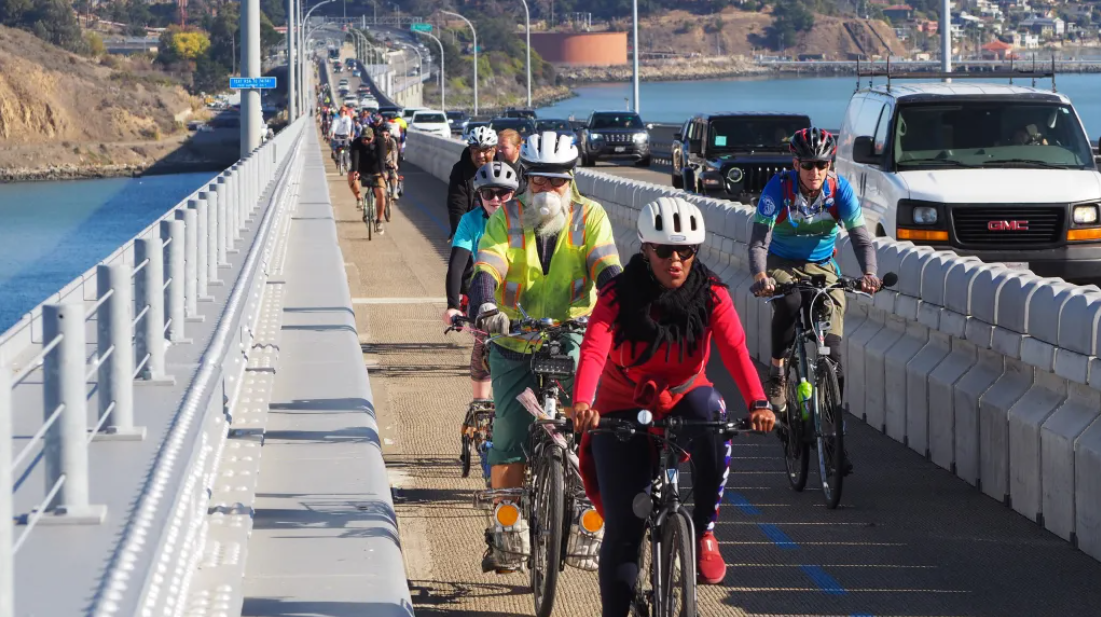SPUR Talk: Reconnecting Oakland to its Waterfront
3:53 PM PDT on May 25, 2017
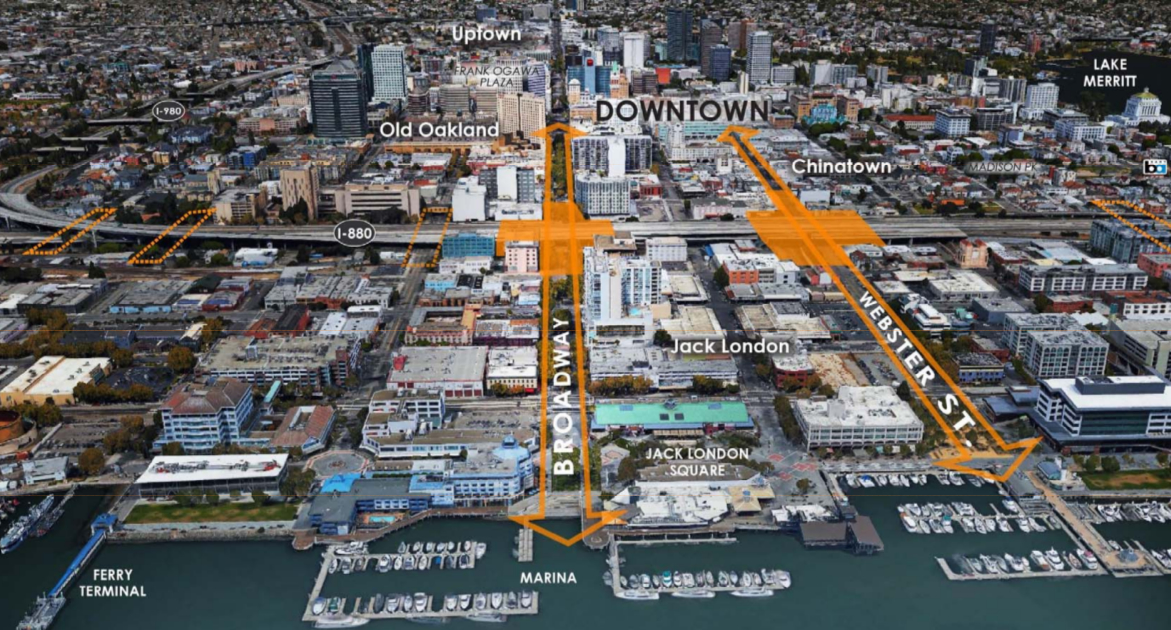
I-880 severs downtown Oakland from Jack London Square. What can be done about it? All Images from the SPUR presentations unless otherwise indicated
Stand in downtown Oakland and look around and it can be easy to forget it's a coastal city. That's because Interstate 880 cuts a giant, uninviting swath between the city center and the waterfront at Jack London Square.
But that could change. Walk this Way: The Broadway/Webster Project aims to make it more inviting to walk under I-880. At a presentation at the San Francisco Bay Area Planning and Urban Research Association (SPUR) earlier this week, Christina Ferracane of the Oakland Bureau of Planning and Savlan Hauser of the Jack London Improvement District gave an update on the project and what it aims to accomplish.
As the project's website puts it, the aim is "...to transform the areas around, under and through the Broadway and Webster Street underpasses of the I-880 Freeway into a beautiful, safe, walkable, inviting, green, and iconic passageway connecting Downtown Oakland and the Waterfront."
That will be a tall order, considering the width of the freeway, its low height, and high-speed traffic on the frontage roads, plus a dozen other bureaucratic and logistical challenges. But the need is critical. "People detest the freeway barrier," said Hauser. "People will organize their whole lives in a way that they don’t have to cross the freeway to get to other parts of Oakland and daily activities. It’s a barrier to life and economic development."
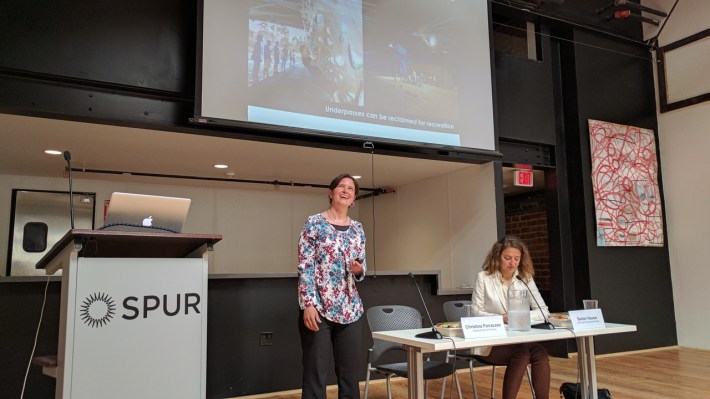
Hauser recalled something she once heard from a Jack London resident: "Whoever designed the Nimitz freeway should be taken out and shot if they’re not already dead." Perhaps that's a bit extreme, and misplaced, since the Nimitz freeway, a.k.a. I-880, is just one of an entire system of freeways throughout the country that have split downtowns in two and ruined the fabric of urban communities. But that doesn't mean the damage can't be, at least partially, undone. In a previous post, Streetsblog wrote about a group that wants to turn I-980 into a boulevard. And then there are the positive impacts of tearing down the Embarcadero freeway in San Francisco and the 101 through Hayes Valley. And, of course, there's Mandela Parkway, the median-separated boulevard that was created when another section of I-880 was re-routed after the Loma Prieta earthquake.
SPUR's Oakland Director, Robert Ogilvie, introduced the talk, saying he hopes that some day I-880 can be put underground through Oakland. But that would be way off in the future--and Walk this Way is about shorter term, affordable fixes. To that end, the project held charrettes in 2011 and 2016. "For the price of some beer and bánh mì sandwiches, we brought a bunch of people into the room from the city and other community stakeholders to think about physical interventions that could improve the underpasses," said Hauser. The stakeholders indicated that the "underpasses should be luminous , dynamic, interactive, and engaging.... It was a high bar to set for a project, but we hope we can achieve all of these things."
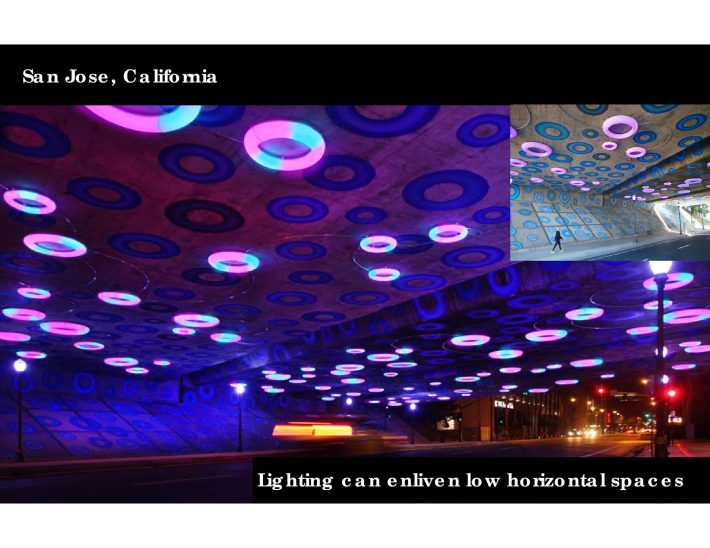
To figure out how, Hauser and Ferracane have been studying similar projects in other cities. They also have been considering solutions crafted specifically for this project. "We had eighteen proposals submitted to the city... with teams from all over the country, from Canada, Japan--over 120 firms represented," said Ferracane. "There's lots of excitement about this project."An artistically lighted underpass in San Jose is probably the closest example geographically, but Ferracane showed images from around the world. Lighting, of course is key, and she had slides of underpasses with some pretty impressive artistic neon and other lighting treatments that would certainly make any underpass better. "Because the freeway is so low, we know that lighting is a big part of the project," said Ferracane. But, she added, that isn't all of it. There are also old buildings with blank, boring walls on both sides of the freeway, such as the Oakland police station on Broadway. Projecting images onto those walls can enliven the approaches to the freeway and therefore make the undercrossing feel more inviting too.

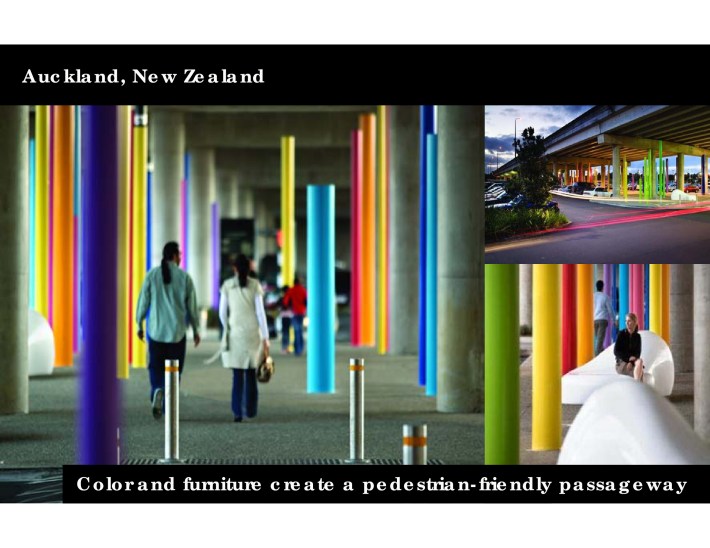
Of course, an additional approach would be to make activity spaces under the freeway to make the passageways more interesting. How about some rock climbing, as with this example from Australia?And, of course, lots of bright colors help, as in this example from New Zealand:Closer to home, Hauser cited the SOMA StrEat Food Park, which sits in the shadow of Highway 101. It occupies what was an ugly spot at Division and 11th Street, but somehow, with all the food trucks and lighting, it is an attractive, enjoyable place to spend some time.
Of course, there's the question of money. Walk this Way is using a Safe Routes to Transit grant, which is appropriate because Webster and Broadway feed to and from BART stations, the ferry, Amtrak, and several bus lines. "That grant does planning and design up to 35 percent," explained Ferracane. "It will take $5-7 million for construction," she said. But she seemed confident they will get the funding. "Oakland has been successful in getting grants for projects. We got funds for the next phase of Telegraph to go from paint to curbs," she added, referring to Telegraph's newish parking-protected bike lanes, and the ATP grant that will allow the city to complete them.
Hauser and Ferracane spent the rest of the session fielding questions (and comments) from an eager audience. One audience member insisted the biggest problem was just keeping it clean underneath the freeway. The speakers tried to explain how complicated even simple solutions can become. Keeping up with the trash, of course, is difficult. But even things as simple as more street lighting can cause problems. For example, they explained, Caltrans objects to the city strapping lighting fixtures to the pillars or underdeck of the freeway, for fear it will interfere with regular seismic examinations and maintenance. There's also the issue of the fast-moving traffic on the frontage roads and ramps, which would make even the prettiest and best-lit underpassing intimidating. One of the solutions is bound to require some serious negotiations with Caltrans: "We're looking at removing the Broadway off-ramp," said Ferracane.
There's also the thorny and heartbreaking issue of the homeless encampments. "Homeless people typically like to transition to places they have been, so the city is thinking about spaces near I-880 for supportive services," explained Ferracane. Let's hope Oakland can be more successful than San Francisco has been with its efforts to work with Caltrans to solve the homeless issues on the infamous "hairball" on Cesar Chavez under Highway 101 in San Francisco.
And from Streetsblog's perspective, most of the proposed solutions that came out of the panel are, of course, cosmetic. The undercrossings have narrow sidewalks with bikes forced to share lanes with drivers making weird last-minute maneuvers (with all the angry honking that invites) as they realize the lane they are in will force them onto the freeway. So is lighting really the first thing that needs dealt with? How about wider sidewalks, protected intersections and phased signaling?
That said, anything that can be done to repair the damage done by the destructive freeway-building age is a welcome effort from Streetsblog's point of view. Jack London Square should be an integral part of downtown Oakland. Let's hope this project can help knit the city back together again.
Do you have ideas for how to make freeway underpasses more walkable and inviting? What are your favorite examples of places where formerly barren areas under freeways and other structures have become usable again? Leave comments below.
For more events like these, visit SPUR’s events page.
Read More:
Stay in touch
Sign up for our free newsletter
More from Streetsblog San Francisco
Commentary: Merchants Are Getting People Killed
The number one local obstruction to curbing traffic violence is commerce and merchant groups.
